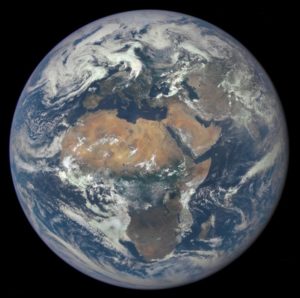
Earth, our home planet, is the third planet from the Sun and the fifth largest planet in the solar system.
Earth is currently the only place in the Universe where life is known to exist.
Around 70 per cent of the Earth’s surface is covered with liquid water.
The Moon is the Earth’s only natural satellite (discounting orbiting rocks), however, the Earth now has over one thousand artificial satellites.
Earth Stats:
- Type: Terrestrial
- Equatorial Diameter: 12,756 km
- Mass: 5.972×1024 kg
- Distance from Sun: 1.017 AU to 0.983 AU
- Sidereal period (day length): 23 hours 56 minutes 4.1 seconds
- Orbital period (year length): 365.256 days
- Number of Moons: 1
- Symbol: ♁ or ⊕ (HTML code: ♁ or ♁)
Structure
Through the analysis of seismic waves created by earthquakes, it has been determined that the Earth contains a solid central inner core composed primarily of iron (80%) and nickel. The inner core is 760 miles in radius and its temperature is estimated to be approximately 5,430 °C at its surface – similar to the temperature of the surface of the Sun.
This is surrounded by an outer core, which is a fluid layer about 1,500 miles thick. It is believed that the Earth’s magnetic field derives from convection in the outer core, combined with the Coriolis effect from the Earth’s rotation.
Beyond the outer core is the Earth’s mantle, the thickest layer of the Earth, which extends from the Earth’s outer layer, the crust, down to a depth of around 1,800 miles. The mantle is divided into the upper and lower mantle of slightly different mineral compositions.
The crust itself typically varies in thickness from around 3 to 6 miles under the ocean floors to between 20 and 30 miles on the continental plates. Although in some mountainous areas such as the Himalayas, the crust is up to around 50 miles thick and the thinnest part of the crust, where the American and African continents meet under the Atlantic Ocean, is only around one mile thick.
The crust and the solid upper part of the mantle, anything from around 25 to 170 miles deep, are collectively known as the lithosphere.
The lithosphere is divided into seven major tectonic plates upon which the continents reside. The plates meet at boundaries often under the oceans, although some plate boundaries are on land.
The mantel just below the lithosphere is more ductile and is known as the asthenosphere. The difference in density and fluidity between the lithosphere and the asthenosphere allows the tectonic plates to move relative to each other – known as continental drift.
Earth’s Atmosphere
Excluding water, the Earth’s atmosphere is composed of around 78 per cent nitrogen, 21 per cent oxygen and 1 per cent argon with small amounts of other trace gases such as carbon dioxide. The exact composition, however, varies with altitude. The atmosphere also contains around 0.4 per cent water vapour, overall, although this reaches around 1 per cent at sea level.
The atmosphere is generally considered to be divided into five main layers. The names and altitudes of these different layers are given below:
- The troposphere – 0 to 7 miles – The lowest atmospheric layer, containing roughly 80 per cent of its mass and nearly all the atmospheric water vapor, meaning that all weather-associated clouds form in this layer.
- The stratosphere – 7 to 31 miles – A layer in which temperatures start to rise with increasing altitude. This is the highest layer of the atmosphere in which jet-powered aircraft can fly. The ozone layer is also contained within the stratosphere
- The mesosphere – 31 to 50 miles – The coldest layer of the atmosphere where temperatures fall with increasing altitude.
- The thermosphere – 50 to 440 miles – Where temperatures again increase with altitude. Many satellites, including the international space station, orbit in this layer.
- The exosphere – 440 to 6,200 miles – the air particles in this layer are so far apart they no longer behaves as a gas and interact with the magnetosphere and the solar wind. Many other satellites orbit in this layer.
Other layers of the atmosphere have also been distinguished, such as the ionosphere, which is spread between the mesosphere, the thermosphere, and parts of the exosphere. The ionosphere is ionised by solar radiation giving rise to the Earth’s auroras. The ionosphere can reflect shortwave radio waves, which can again be reflected from the ground and back again allowing radio communication to extend well beyond the horizon.